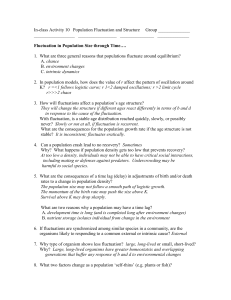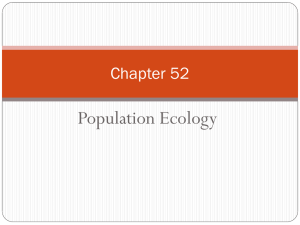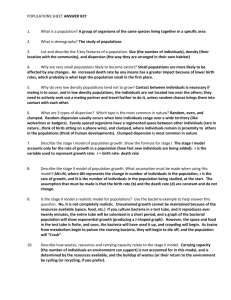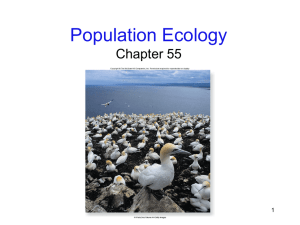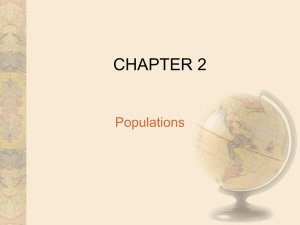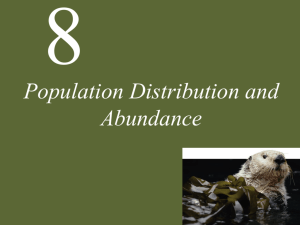09 Lecture Pop Fluc + Struc10
advertisement
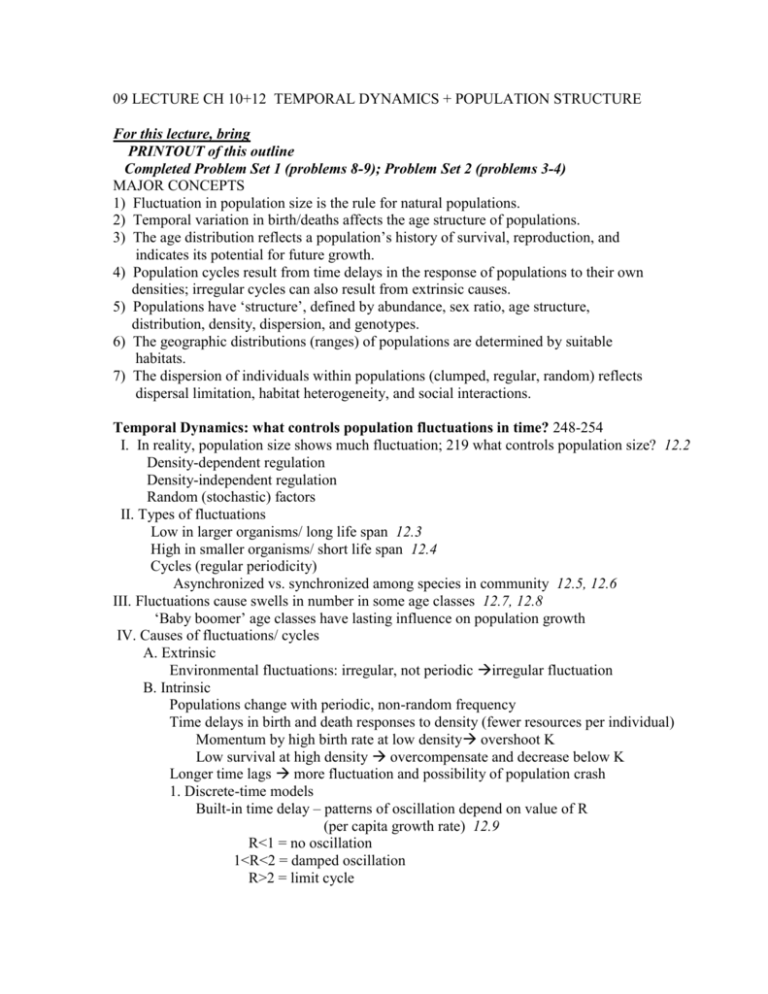
09 LECTURE CH 10+12 TEMPORAL DYNAMICS + POPULATION STRUCTURE For this lecture, bring PRINTOUT of this outline Completed Problem Set 1 (problems 8-9); Problem Set 2 (problems 3-4) MAJOR CONCEPTS 1) Fluctuation in population size is the rule for natural populations. 2) Temporal variation in birth/deaths affects the age structure of populations. 3) The age distribution reflects a population’s history of survival, reproduction, and indicates its potential for future growth. 4) Population cycles result from time delays in the response of populations to their own densities; irregular cycles can also result from extrinsic causes. 5) Populations have ‘structure’, defined by abundance, sex ratio, age structure, distribution, density, dispersion, and genotypes. 6) The geographic distributions (ranges) of populations are determined by suitable habitats. 7) The dispersion of individuals within populations (clumped, regular, random) reflects dispersal limitation, habitat heterogeneity, and social interactions. Temporal Dynamics: what controls population fluctuations in time? 248-254 I. In reality, population size shows much fluctuation; 219 what controls population size? 12.2 Density-dependent regulation Density-independent regulation Random (stochastic) factors II. Types of fluctuations Low in larger organisms/ long life span 12.3 High in smaller organisms/ short life span 12.4 Cycles (regular periodicity) Asynchronized vs. synchronized among species in community 12.5, 12.6 III. Fluctuations cause swells in number in some age classes 12.7, 12.8 ‘Baby boomer’ age classes have lasting influence on population growth IV. Causes of fluctuations/ cycles A. Extrinsic Environmental fluctuations: irregular, not periodic irregular fluctuation B. Intrinsic Populations change with periodic, non-random frequency Time delays in birth and death responses to density (fewer resources per individual) Momentum by high birth rate at low density overshoot K Low survival at high density overcompensate and decrease below K Longer time lags more fluctuation and possibility of population crash 1. Discrete-time models Built-in time delay – patterns of oscillation depend on value of R (per capita growth rate) 12.9 R<1 = no oscillation 1<R<2 = damped oscillation R>2 = limit cycle R>>2 = crash 2. Continuous-time models 12.10 No built-in time delay Time delays result from Development period separating reproductive episodes Storage of nutrients If eliminate time delay, eliminate cycle 12.12, 12.13 Summary 1-5 Population Structures 198-200; Define population and subpopulation; 10.2 Identify population ‘structures’ (descriptors; see below) I. Abundance (population size) Estimating population size Mark-recapture method M/N = R/S (see lab manual; mammal lab!) 10.19 Complete census Number of individuals, sex ratio, and age structure Problems if can’t age individuals; or if size does not = age (plants) What counts as an individual in plants? Ramet – repeating modular units from vegetative propagation 10.13 Genet – all ramets of same genotype II. Distribution (range) 200-3; 206-7 10.3; Individual fitness is highest within the natural distribution of a species 10.14 Range is seldom continuous or static Invading species can spread rapidly beyond their initial range 10.11, 10.21 Most species have small ranges Ranges of mammals increase with increasing latitude Species with wider distributions have greater abundance 10.24 Geographic distributions of populations defined on different spatial scales Factors limiting geographic distribution Dispersal (migration) 10.5, 10.6, behavior, other species, abiotic factors, chance, history Over the distribution, much spatial variation in population density 10.27 III. Density (no. / unit area) 216-218 Depends on suitable habitat Often highest at center of species’ geographic range 10.15 Declines as body mass increases (log – log) 10.25 IV. Dispersion (spacing of individuals with respect to others in population) 207-9 Clumped, random, uniform (even) 10.11, 10.12 Factors affecting dispersion Habitat heterogeneity, dispersal limitation 10.14, reproductive mode, interactions 10.12 Summary 1,4,6,7,12,14


